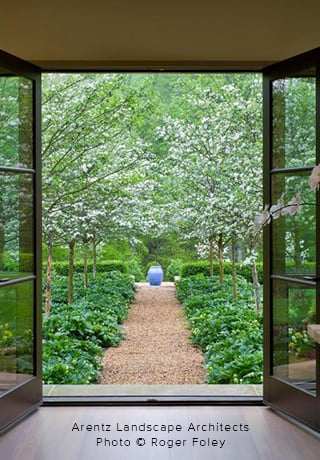Rooted in Imagination: Tanner Garden Blends Plants, Art and History
Freeland and Sabrina experiment, reimagine, and create an extraordinary, deeply personal garden on their Napa propertyFreeland Tanner's roots run deep in this 1-acre property nestled in Napa Valley, where generations of his family have walked the land. As you wander through the garden beneath the towering trees planted by his mother and grandfather decades ago, you can almost hear the whispers of the past mingling with the vibrant energy of today. But it wasn’t until 1987, when Freeland and his wife, Sabrina, began building their first home here, that the garden blossomed into the paradise it is now.
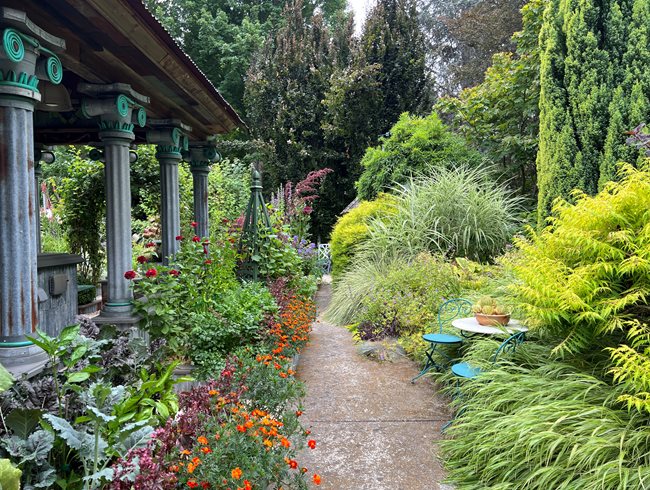
Freeland and Sabrina’s garden is a feast for the senses, with a vast array of plants perfectly placed to highlight their best qualities. This garden is a plant collector’s dream, filled with edibles, succulents, tropicals, old stalwarts with new and cutting-edge varieties, perennials, bulbs, and rarities you’ve only read about! And sprinkled throughout are Freeland’s incredible artwork and structures, coming together to create an experience like none other.
Although Freeland and Sabrina are celebrated landscape designers, this is their personal garden, where their hearts and imaginations freely roam. In this garden, they experiment with unexpected plant pairings, reimagine traditional design principles, and create extraordinary, deeply personal artistic structures that are out-of-this-world yet feel perfectly at home. And because this garden is so precious to them, they tend to it with their own hands (no team of gardeners here!), pouring their love and creativity into every square inch.
Having had the pleasure of visiting this garden many times over the years, in every season, I'd like to share some of the magic that makes it so special and how you might bring a touch of that enchantment into your own garden.
1. HAVE FUN WITH COLOR
Specific colors, like chartreuse and purple, weave throughout the garden, creating a sense of continuity and a unifying flow among the different spaces. These "color echoes" act like a ribbon, seamlessly tying together the distinct garden beds and calming any potential visual clutter. However, overuse of repetition can lead to predictability and monotony in the garden.
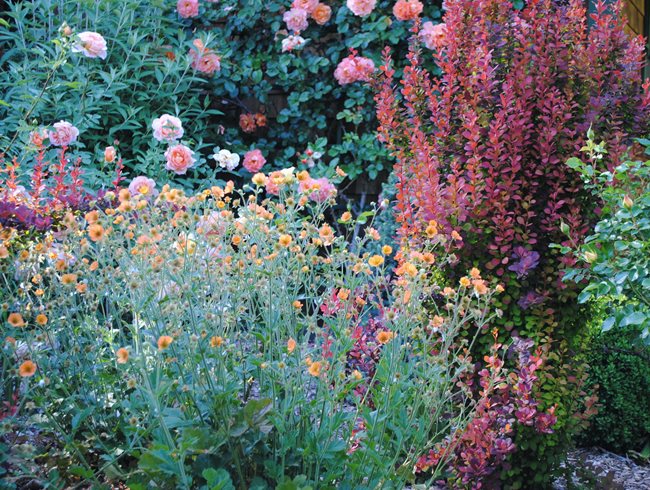
The soft peachy tones of Berberis ‘Orange Rocket’, Geum ‘Tangerine Dream’, and ‘Lady of Shalott’ roses beautifully harmonize with one another, creating a warm and inviting color palette. Together, they form a visually cohesive grouping that draws the eye and adds a sense of continuity to the garden bed. This combination of colors and textures adds depth and richness, making the garden feel both dynamic and serene.
To keep the garden from appearing predictable, Sabrina, with her keen eye for color, adds unexpected pops of contrasting and complementary colors, bringing moments of delightful surprise. A perfect example is Cluck’s Garden, named after their beloved hen whose chicken coop was in this area. Shades of terra-cotta, soft orange, and pale peach predominate and create a warm and inviting palette.
2. CELEBRATE THE ‘SOUL’ OF YOUR GARDEN
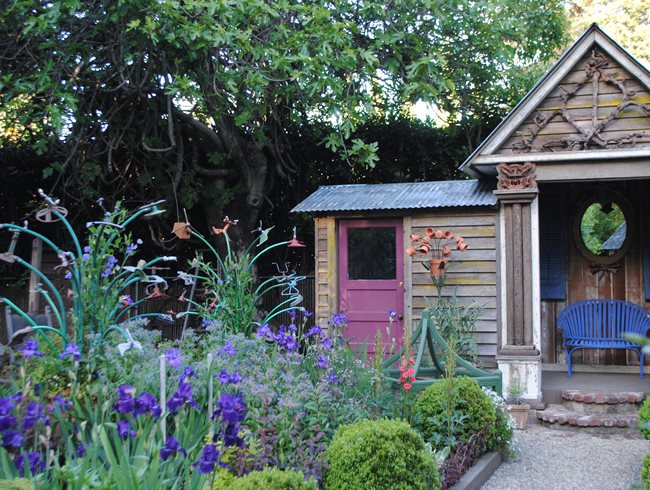
In this part of the garden, Freeland lovingly built what he calls ‘Sabrina’s Temple’—a private place to call her own, filled with her favorite cherished heirlooms and garden treasures. Whimsy abounds in this garden, as seen in Freeland’s extensive collection of antique sprinklers repurposed into unique garden art, adding a playful touch to the landscape.
In addition to being a skilled garden designer, Freeland is an accomplished artist, creating some of the most breathtaking garden art and structures I've ever seen. When showcasing his art and structures, Freeland relies on Sabrina’s help to finesse the final placement within the garden. This is another way they add their personal touches, breathing life into the space and giving the garden its soul. While not everyone can craft art for their garden, incorporating personal touches makes a garden truly unique and memorable. Why not use your garden to display personal collections, commemorate a special trip, or honor a loved one? With thoughtful integration, art and plants transform a garden into a powerful reflection of who you are.
3. MIXING EDIBLES AND ORNAMENTALS
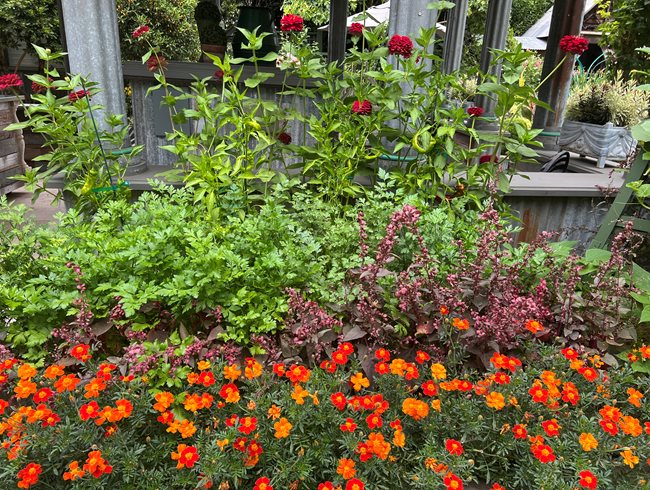
In this edible bed, red orach (Atriplex hortensis), which has a taste and texture similar to spinach, and frilly parsley create a lush, textured backdrop for the vibrant zinnias that intersperse among them. The zinnias, with their warm shades of burgundy and orange, harmonize with the rich colors of the orach leaves, creating a bed that’s both productive and picturesque.
Growing edibles is another of Sabrina’s passions, whether she starts from seeds or young plants. When selecting which edibles to grow, she looks for more than just fantastic taste; she seeks out varieties with unique foliage textures, colors, or shapes that can seamlessly blend into the existing garden beds. Herbs and vegetables happily intermingle with ornamental, non-edible plants, adding a creative twist to traditional gardening (see Aiming for Aesthetic Edibles). This approach maximizes space while adding layers of interest and complexity to the garden's design. It's a fantastic idea, especially for those without room for a dedicated vegetable garden. Mixing edibles and ornamentals in a single planting bed allows you to create a visually stunning garden with the added benefit of providing fresh, homegrown produce. This combination of beauty and practicality is perfect for those who want their gardens to be as productive as they are beautiful.
4. CARVING OUT INTIMATE SPACES
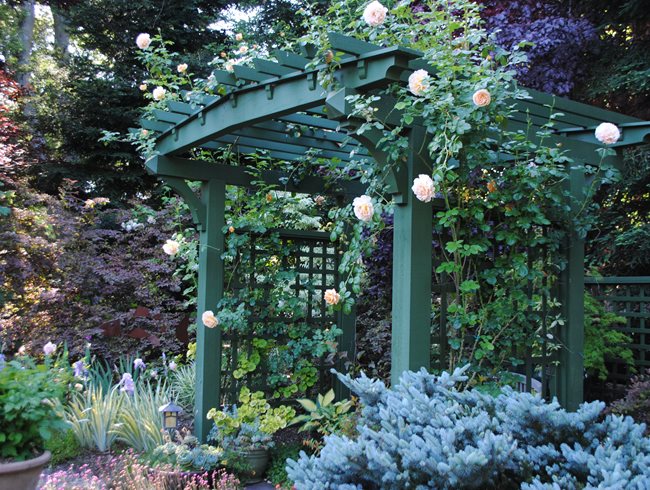
An arbor built by Freeland is the perfect support for a profusion of fragrant climbing roses, their scent filling the air. This serene spot is best enjoyed by sitting on the nearby bench, where you can fully appreciate the beauty and aroma of the roses cascading overhead, creating a peaceful and inviting retreat within the garden.
Intimate spaces are thoughtfully placed throughout the Tanner garden, offering a variety of cozy spots for relaxation and contemplation. These spaces range from charming outdoor structures with a bench just for two, to a discreetly positioned gazebo, or even something as simple as two chairs tucked away in a quiet corner. For the Tanners, it's essential to have these pockets of tranquility where one can pause, even for a moment, and fully immerse themselves in the garden's beauty. This approach serves as a valuable lesson for all gardeners, regardless of the size of their garden. By incorporating such intimate spaces, you add depth and character to the garden and a sense of mystery and discovery. Creating these special spots enhances the garden experience, making it a more personal and engaging space.
5. BE BOLD WITH FOLIAGE
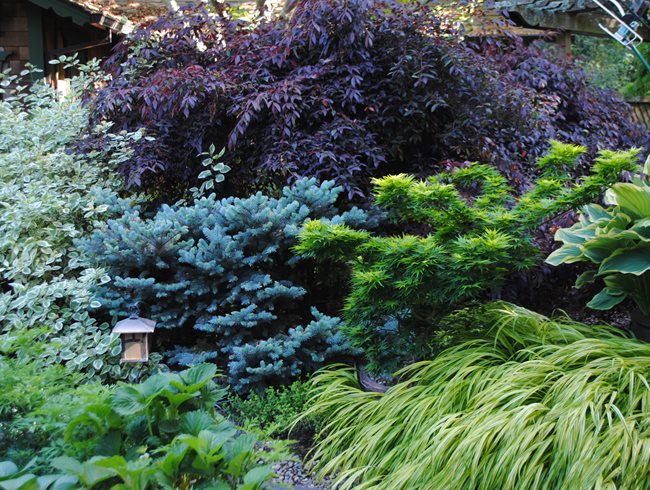
This vibrant combination of foliage showcases a rich tapestry of colors, including maroon, blue, chartreuse, variegated patterns, and lush green. The colors are further enhanced by contrasting shapes and textures—long and thin leaves, oversized and rounded ones, and thick, wavy foliage next to smoother varieties. Together, these elements create a gorgeous display that captivates the eye, proving that a garden can be dynamic and captivating without a single flower in bloom.
Freeland once said, “Creating a tapestry from texture, shape, and form—THIS is what drives the garden for me.” This philosophy is evident throughout the garden, where one stunning combination follows another, skillfully contrasting the colors and textures of foliage and their sizes (see Designing with Foliage Over Flowers). In even the narrowest beds, Freeland uses oversized and bold foliage, which creates the illusion of a larger space. In contrast, the overuse of plants with small foliage in a limited space can actually make an area feel even more confined. Freeland masterfully combines contrasting shapes, textures, and colors, resulting in garden beds that maintain their beauty far longer than those filled solely with flowers.
6. THE IMPORTANCE OF PATHWAYS
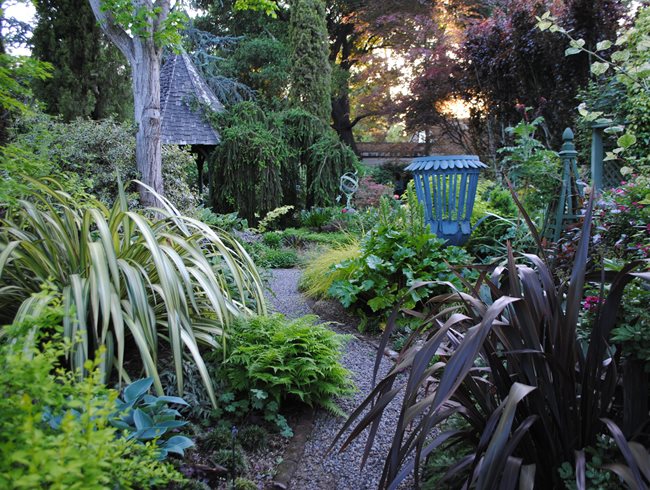
Flanked by oversized phormiums, the narrow, winding path feels intimate and enclosed, heightening curiosity about what lies ahead. Along the way, unique pieces of Freeland’s art are strategically placed, adding an element of surprise and intrigue to the journey. The path creates a sense of adventure and discovery that makes the garden experience feel like a personal journey into the unknown.
When visiting the Tanner’s garden, it becomes clear that exploring the entire space is a journey that begins at the garden gate, leading onto a pebble pathway that softly crunches underfoot. The gently winding paths take you through a series of distinct, unique areas, each with its own surprises waiting around every corner. As Freeland says, "A garden should be a series of events that unfold as you walk through the pathways. Otherwise, the eye gets tired if you see too much of one thing at once." There is no rushing down a straight path from point A to point B; instead, the garden invites you to take a leisurely stroll, offering ample time to absorb the beauty and surprises, with occasional glimpses of what lies beyond.
Learn more about designing garden pathways.
7. FOCUS ON TRANSITIONAL MOMENTS
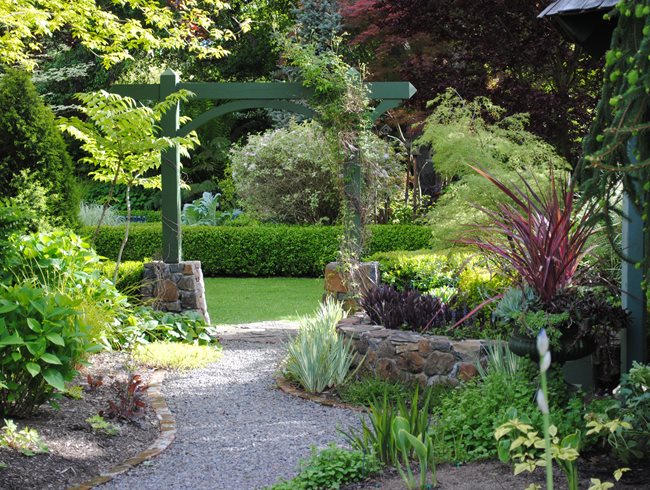
A simple yet elegant green trellis stands at the end of the path, serving as a graceful transition into a new garden room beyond. Adorned with climbing vines, it hints at the surprises ahead. The trellis marks the entrance to a different space and creates a sense of anticipation, drawing visitors through its open archway. Framing the view ahead offers a glimpse of the other side, enhancing the sense of journey and discovery within the garden.
Transitions play a crucial role in the Tanner’s garden, enhancing the experience of moving from one garden room to another. As mentioned above, the gently winding pathways lead visitors seamlessly through the garden, but for Freeland, it's also important to clearly mark the shift between different spaces. Each pathway’s beginning and end signal to the visitor that they are leaving one area and entering another. These transitions can take various forms, such as structures built by Freeland that act as gateways or thresholds. A transition can also be as simple as strategically placing a few bold, structural plants to create a visual cue, subtly guiding the visitor and preparing them for the next garden experience. These transitional elements provide a clear sense of movement and progression and contribute to the garden's overall narrative, making each new area feel like a fresh chapter in a story.
RELATED:
More from Rebecca Sweet
'Picture Perfect' Garden in Napa
How to Create a Colorful Garden
